The enduring echoes of Moorish Spain
New York Times
last updated: Sep 15,2022

There is a way through Spain that is all
horseshoe arches, keyhole windows, and bronze doors carved in Arabic script. It
meanders into crenelated forts, Moorish castles overlooking the Mediterranean,
and grand mosques reconfigured by Christians into cathedrals.اضافة اعلان
As the child of an Iraqi woman and a Swedish American man, I have always been drawn to places where West and East converge and dissolve into each other. The southern edge of Spain, where North Africa is just an hour away by water, is one of these places.
One midsummer week, my husband and I immersed ourselves in what remains of Moorish Spain, places that brought to mind the sights, sounds, and scents of childhood visits to my mother’s homeland. We took an impossibly romantic path through Seville, Córdoba, Granada, Málaga, the port city of Tarifa, and, finally, by ferry across the Strait of Gibraltar, to Tangier, Morocco.
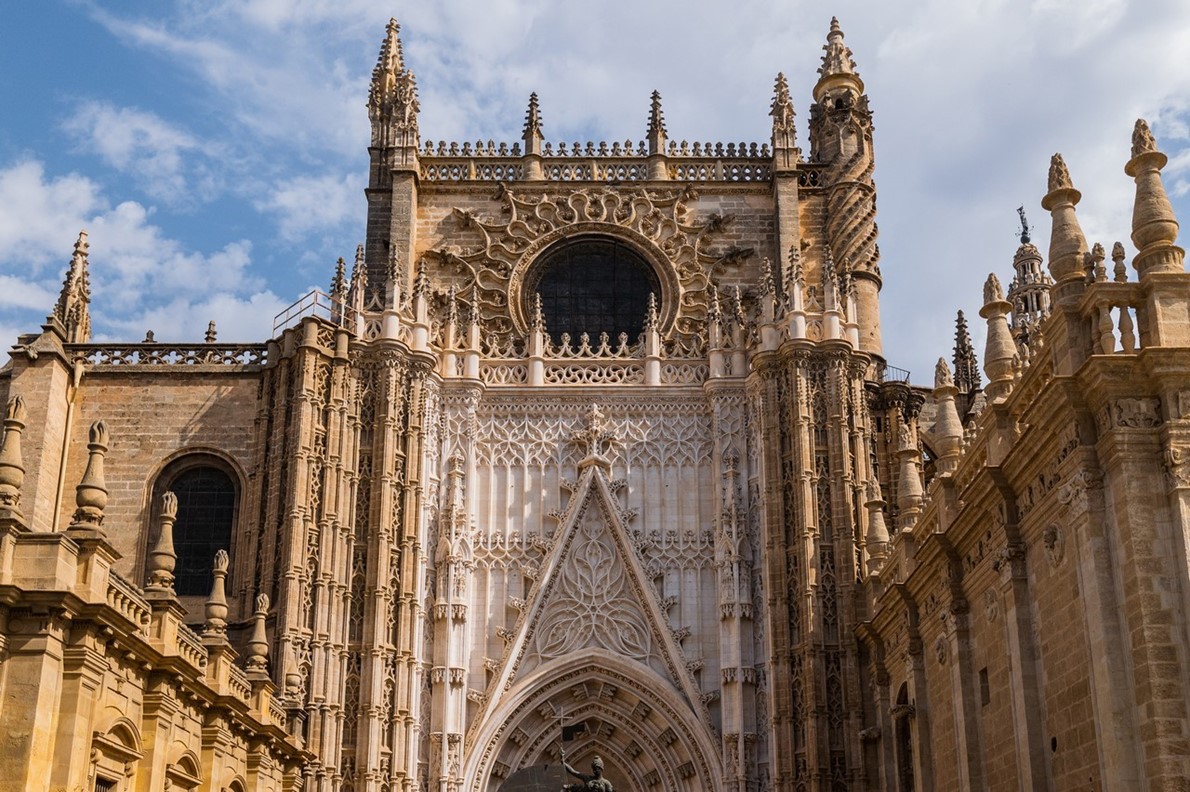
The Seville Cathedral, a UNESCO Heritage site and one of the largest churches in the world, in Seville, Spain on August 6, 2022.
Arab influence in Spain dates to the early 700s, not long after the founding of Islam, when Muslims from North Africa crossed the Strait of Gibraltar (from the Arabic for “Tariq’s rock”). The Europeans called the invaders Moors, after Mauretania, the Roman name for North Africa. Over the centuries, the Moors left a legacy in Spanish architecture, music, food and language in the region they then called Al-Andalus. The name of Spain’s greatest hero, El Cid, comes from the Arabic honorific, Sayid. The 16th-century novelist Miguel de Cervantes framed his fictional story of the knight-errant Don Quixote as the translation of a recovered Arabic manuscript.
Where cultures meet and endure
We started off in Seville, the capital of the South’s Andalusia region, arriving as a sunset haze made gold silhouettes of church domes and former minarets on the skyline. The slow, pale-green river that flows through both Seville and Córdoba is called the Guadalquivir — a Spanish pronunciation of the Arabic wadi-al-kabir, or big valley. Many other rivers in Spain contain the same Arabic root word for valley or riverbed, like the Guadalmedina and the Guadiana.
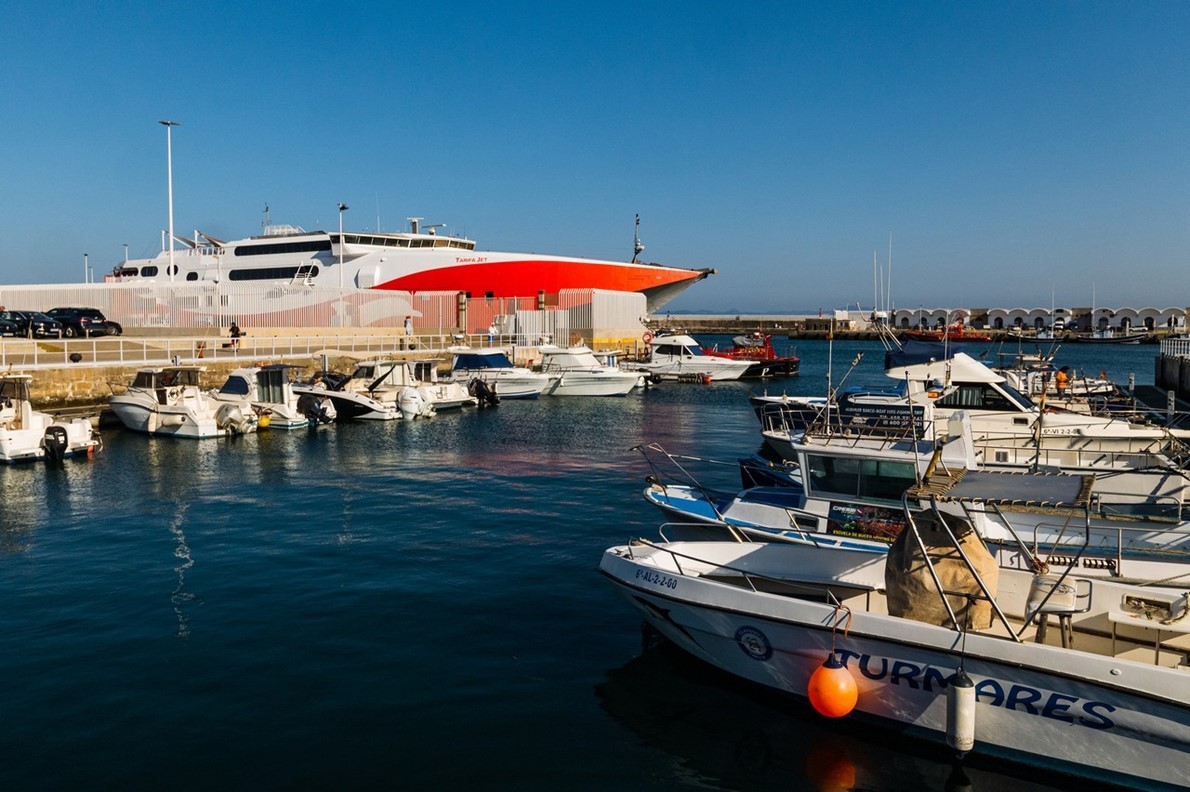
The port city of Tarifa, Spain on August 8, 2022, where travelers can take a short ferry to a new continent and arrive in Tangier, Morocco.
Early in the morning, we hit our jet lag with double espressos and bizcocho, a sweet, spongy cake, then strolled what is still called the Jewish quarter, despite the Jews’ expulsion more than 500 years ago, past houses painted the colors of hay and bull’s blood, to the Seville Cathedral and the Alcázar (the Moorish rulers’ castle and gardens).
The Seville Cathedral — a UNESCO Heritage site and one of the largest churches in the world — was constructed on the site of the 12th-century Great Mosque. The cathedral’s massive blackened bronze door is carved with intricate, geometric Arabic calligraphy called Kufic and wide enough to let a team of horses through.

A market in Tangier, Morocco, on August 8, 2022.
Throughout Andalusia, there is no clear-cut line between Christian and Muslim architecture. The Spanish Christians who eventually conquered the Moors and expelled the Muslims and the Jews during the Inquisition, starting in 1492, did not tear down all the Moorish work. They applied Muslim decorative motifs to their own architecture, in a design style called Mudéjar (a word that also refers to the Muslims the Christians allowed for a time to remain).
In one convent that we visited in Seville, for example, icons of haloed saints and a crucified Christ hang under ceilings with intricate patterns of inlaid wood. The two cultures and their stylistic differences — the Islamic preference for complex geometry and the Christian depiction of living creatures — exist side by side.
A seat of coexistence and progress
From Seville, we drove east along the Guadalquivir to Córdoba, which has been called “the ornament of the world.” Our first night in Córdoba, we woke just before dawn to a quavering wail wafting through an open hotel window. For a moment, I was back in the Baghdad summer of my childhood, sleeping on the rooftop of my grandmother’s house on little beds with mosquito nets, when the same sound would wake me in the starlit night.
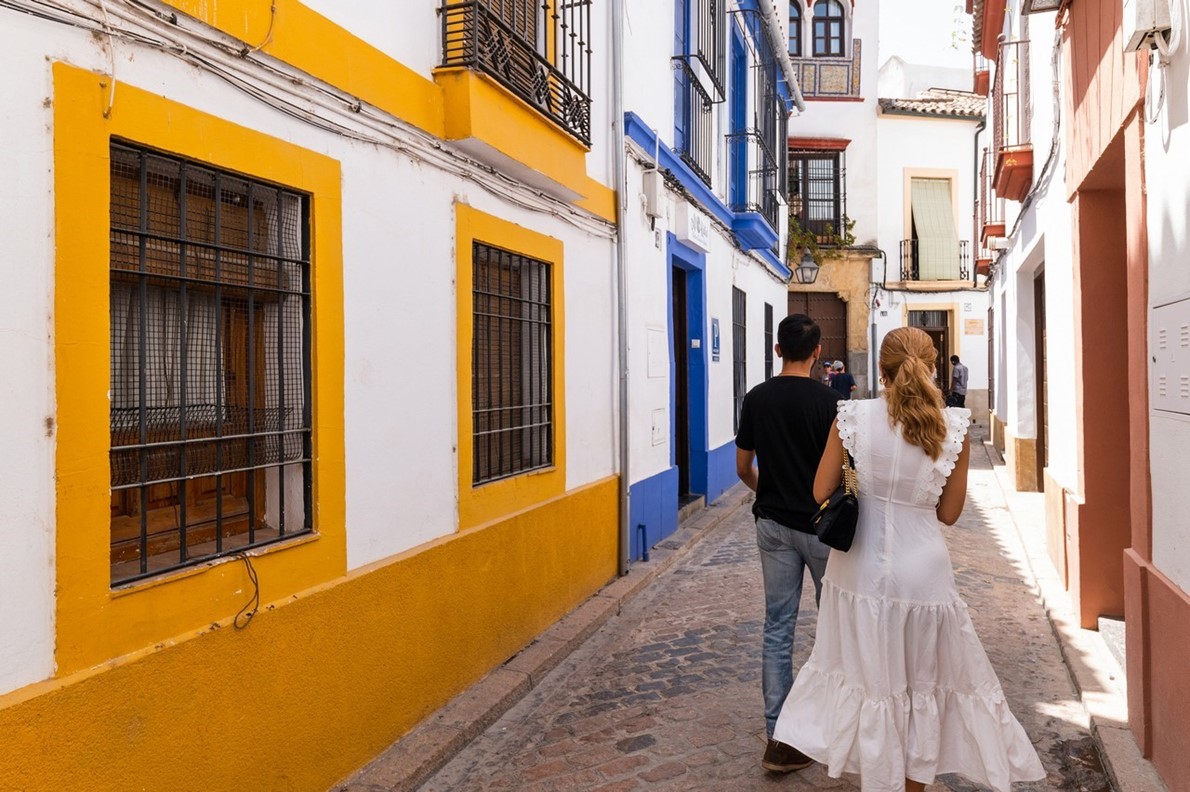
People walk the streets of Córdoba, Spain on August 10, 2022.
Muezzins, who call Muslims to prayer, have not sounded from the Christianized minarets of Andalusia, Spain’s largest region, for centuries. But the duende of flamenco happens — and maybe not by accident — to sound much the same. Duende is a complex Spanish word that means spirit, magic, and passion. It is also the name for the plaintive, wordless singing in Spain’s signature folk music.
Musicologists are unsure of flamenco’s origins. One etymology proposed by 19th-century Andalusian historian Blas Infante is that the word flamenco comes from the Arabic words for rural wanderer. Certainly, the emotional keening evokes the human and cultural loss and ghosts of hundreds of thousands of Jews and Muslims thrown out of Spain after seven centuries of coexistence.
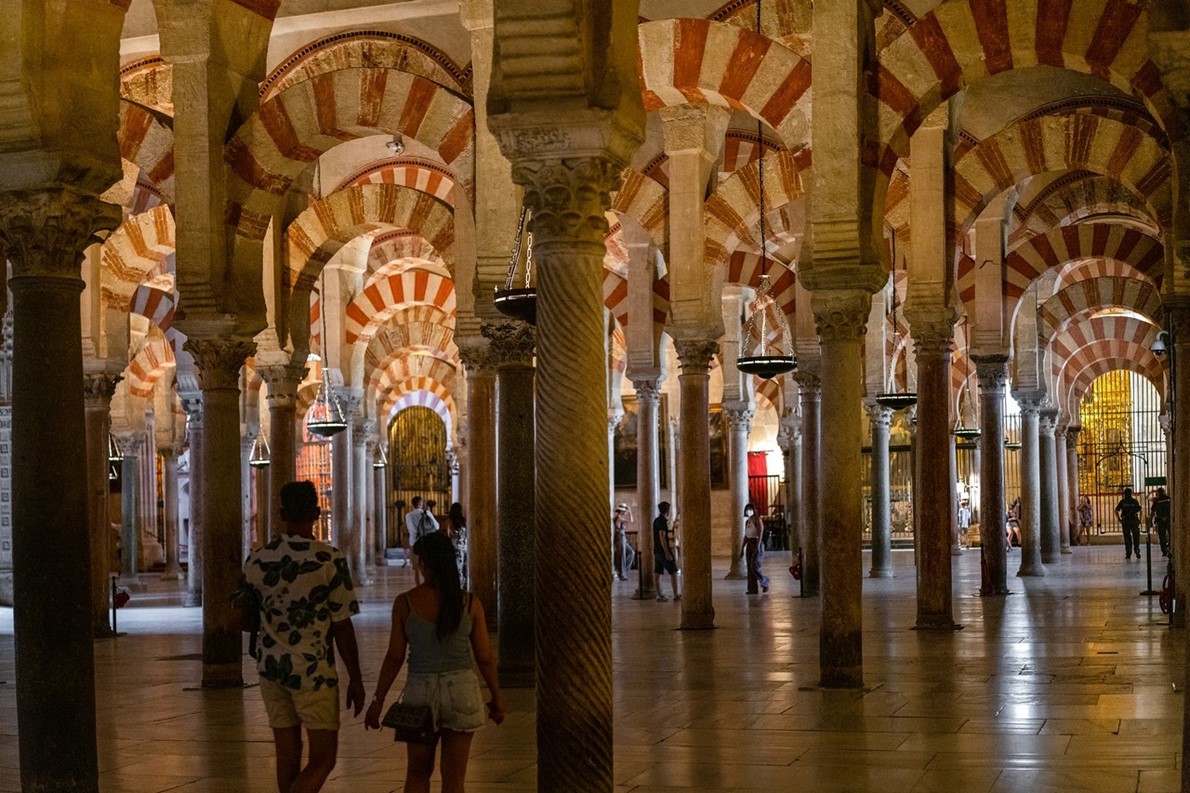
Córdoba’s Mosque-Cathedral, or La Mezquita, in Córdoba, Spain on August 6, 2022, which was one of the first and grandest mosques in Europe.
Córdoba’s Mosque-Cathedral, or La Mezquita, is another UNESCO World Heritage site. Here the physical and spiritual contrasts between Islam and Christianity are embedded in the walls. The massive mosque, covering nearly 24,247sq.m., was built in 784 and then expanded by succeeding generations of Muslim rulers known as caliphs. It was one of the first and grandest mosques in Europe, a forest of 856 columns supporting 365 red-and-white-striped arches. The arrangement of the pillars gives the illusion of shifting diagonal lines. The simplicity and vastness suggests an unadorned void, ideal for contemplating eternity. Standing before the one center of color, the glowing, surreal mihrab (the Mecca-facing prayer niche found in mosques), inlaid with precious stones, is like staring into the sun.
In the midst of this icon of Islamic architecture, 16th-century Spanish Catholics implanted a Gothic cathedral. Today, in the heart of this forest of arches, Christ on the cross hangs over a central nave lined with tall silver and gold candlesticks. Crowned, gilt-plaster Madonnas peek out of Islamic keyhole-shaped niches. Dozens of porticoes along the outer walls are bricked in and divided into dark, gated rooms holding saints’ bones, and candlelit altars. Viewed from the top of the nearby bell tower (the former minaret, which one can climb for a few euros), an alien Gothic-buttressed spaceship appears to have landed in the middle of the roof.
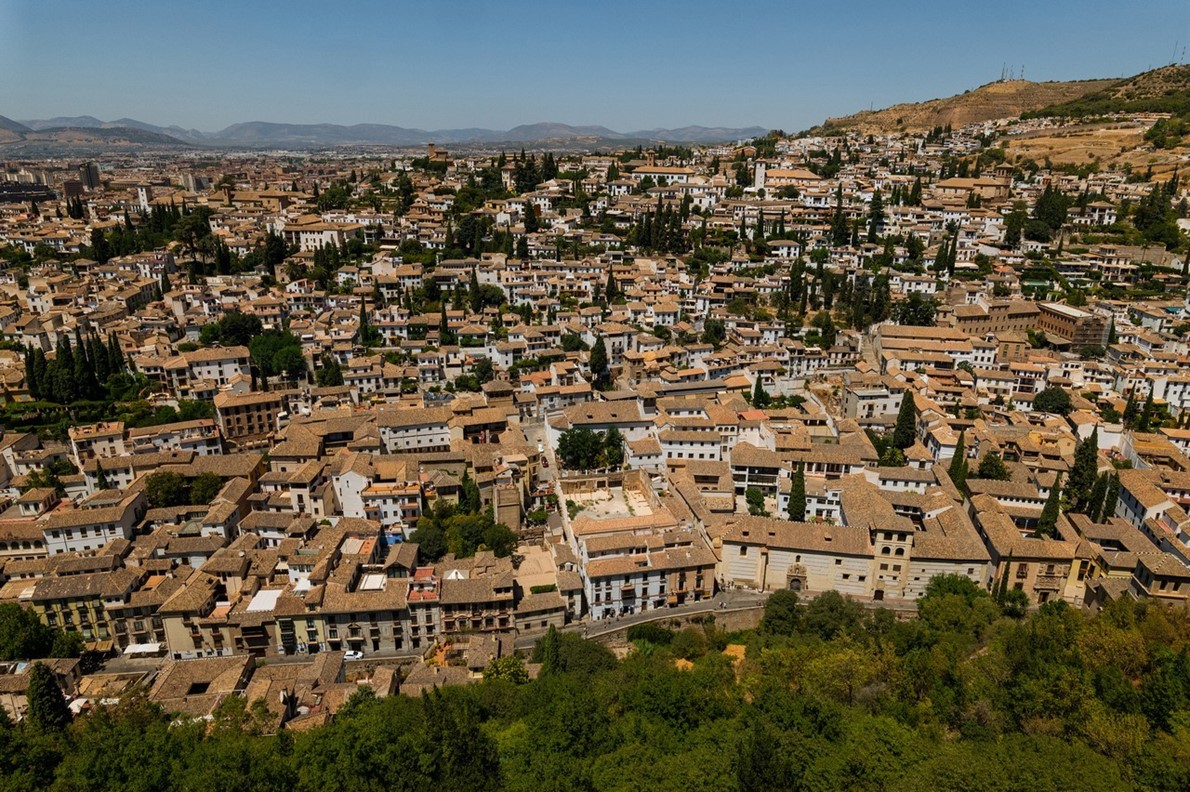
A view of Granda, Spain on August 7, 2022.
Muslims are prohibited by the Catholic Church from praying inside the Mosque-Cathedral. In the early 1970s, the Saudi government offered to pay Spain millions of dollars to move the cathedral out of the mosque and construct it nearby. Spain’s former dictator, Francisco Franco, supported the idea, but the cathedral’s bishop and others opposed it, and ultimately the plan was shelved.
At its zenith, from roughly the late eighth through the 10th centuries, Córdoba was a place of unusually peaceful coexistence between Christians, Jews, and Muslims. Sometimes called “la convivencia” during this period, Jewish and Christian intellectuals from all over Europe came to this Moorish seat of power, translating classical texts from Hebrew, Greek, and Latin and advancing studies of medicine, philosophy, math, and astronomy.
Historians are not in full agreement about the extent of Andalusian tolerance then, and even today, conflicts persist over who gets to pray inside La Mezquita. But in an interview with me over coffee, not far from the Mosque-Cathedral, the Córdoba University lawyer and historian Antonio Manuel Rodríguez Ramos argued that la convivencia was real. “Here in Córdoba, within 500 meters, you find the mosque, the chapel of St. Bartholomew and the synagogue. They prayed together. The convivencia existed, and it ended when Jews and Moors were expelled.”
A castle in the clouds
The crown of all Moorish castles is the magnificent Alhambra in Granada. It hovers above the city like a mirage, a castle in the clouds. Strolling this labyrinth of muqarna (a honeycomblike, ornamental vaulting) and ornate white stucco walls is like a surreal trip into a giant vitrine of carved ivory. The vast complex is said to be laid out as a complicated geometric game. Evidence of an intense focus on math is everywhere. The placement of starlike patterns embedded in the arched ceilings, for example, required countless complicated calculations — by human brains, not machines.
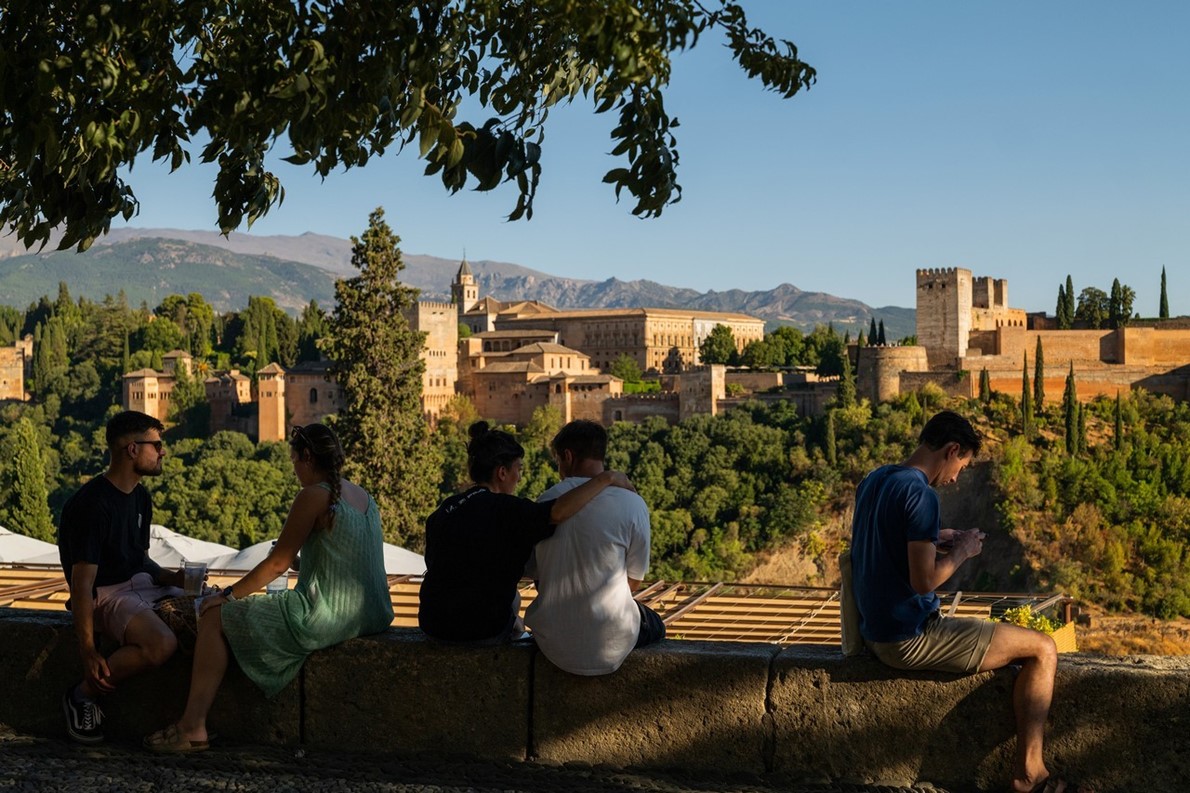
The crown of all Moorish castles is the magnificent Alhambra which hovers above the city like a mirage in Granda, Spain on August 7, 2022.
British and American writers, including Washington Irving and Henry Wadsworth Longfellow, have waxed lyrical trying to describe the (usually moonlit) splendor of the Alhambra. Some of them even spent a night or two sleeping on tiled floors among its trickling fountains and delicate arched porticoes. We stayed in a small hotel with a Moorish-style central courtyard, called the Casa Morisca. It’s perched on a hill across from and far below the castle, where the Darro River that once sustained the great compound trickles along the outdoor cafes of the Paseo de los Tristes.
The Alhambra was the final stronghold of the last Muslim rulers in Spain, the Nasrids. Their handover of its keys to the Catholic rulers — with Christopher Columbus present at the ceremony, about to set off for the West — marked the end of 781 years of Moorish Spain. It is also a name that still resonates in the Arab world, where generations of people like my mother, a Christian raised in Muslim Iraq, grew up hearing of this storied place, but who, like her, never visited.
On the final leg of the journey, we drove south as far as we could go. The outlines of the edge of another continent — the North African homeland of the original Moors, and the land to which many of the expelled Jews and Muslims fled — slowly appeared in the haze across the Mediterranean.
Passports in hand, we boarded a ferry in the little port of Tarifa, (named after the Moorish military commander, Tarif ibn Malik, and origin of the English word for import taxes, the tariff). The short, storied crossing between two continents had long been a dream of mine. For 45 minutes, I was transfixed by the waves lapping the side of the ship, thinking of the water’s role in centuries of migration and blended cultures. We left Europe behind and docked in another world, in Tangier, Morocco, an Arab city whose streets, like the Baghdad of my memory, smell of orange blossom, and diesel.
Descendants of those expelled from Spain still live in the northern coastal regions of Morocco (covered in a new documentary, “Children of al-Andalus”). Some even possess real or symbolic keys to their lost houses. One of these descendants, Abdel El Akel, has a large iron key passed down for hundreds of years through the eldest male of this family. According to family lore, the first El Akel was a wealthy Nasrid builder who fled Granada in 1492 and built the first mosque in the Moroccan city of Chefchaouen. El Akel is also the name of the mosque.
Spain has offered to repatriate descendants of the expelled Jews, but it has not extended that invitation to Muslims, although some have asked. El Akel said he has no desire for Spanish citizenship. The family doesn’t even know what building their key supposedly once unlocked. But El Akel, a lean, quiet, retired architect and banker who invited me to meet at his summer home near Tétouan, on the Mediterranean coast, kept his family heritage alive by educating his three children in Spanish schools from childhood. They attended universities in Spain. All three are now living and working in Granada — the first members of the family to return after four centuries.
The key stayed in Morocco.
Read more Travel
Jordan News
As the child of an Iraqi woman and a Swedish American man, I have always been drawn to places where West and East converge and dissolve into each other. The southern edge of Spain, where North Africa is just an hour away by water, is one of these places.
One midsummer week, my husband and I immersed ourselves in what remains of Moorish Spain, places that brought to mind the sights, sounds, and scents of childhood visits to my mother’s homeland. We took an impossibly romantic path through Seville, Córdoba, Granada, Málaga, the port city of Tarifa, and, finally, by ferry across the Strait of Gibraltar, to Tangier, Morocco.

The Seville Cathedral, a UNESCO Heritage site and one of the largest churches in the world, in Seville, Spain on August 6, 2022.
Arab influence in Spain dates to the early 700s, not long after the founding of Islam, when Muslims from North Africa crossed the Strait of Gibraltar (from the Arabic for “Tariq’s rock”). The Europeans called the invaders Moors, after Mauretania, the Roman name for North Africa. Over the centuries, the Moors left a legacy in Spanish architecture, music, food and language in the region they then called Al-Andalus. The name of Spain’s greatest hero, El Cid, comes from the Arabic honorific, Sayid. The 16th-century novelist Miguel de Cervantes framed his fictional story of the knight-errant Don Quixote as the translation of a recovered Arabic manuscript.
Where cultures meet and endure
We started off in Seville, the capital of the South’s Andalusia region, arriving as a sunset haze made gold silhouettes of church domes and former minarets on the skyline. The slow, pale-green river that flows through both Seville and Córdoba is called the Guadalquivir — a Spanish pronunciation of the Arabic wadi-al-kabir, or big valley. Many other rivers in Spain contain the same Arabic root word for valley or riverbed, like the Guadalmedina and the Guadiana.

The port city of Tarifa, Spain on August 8, 2022, where travelers can take a short ferry to a new continent and arrive in Tangier, Morocco.
Early in the morning, we hit our jet lag with double espressos and bizcocho, a sweet, spongy cake, then strolled what is still called the Jewish quarter, despite the Jews’ expulsion more than 500 years ago, past houses painted the colors of hay and bull’s blood, to the Seville Cathedral and the Alcázar (the Moorish rulers’ castle and gardens).
The Seville Cathedral — a UNESCO Heritage site and one of the largest churches in the world — was constructed on the site of the 12th-century Great Mosque. The cathedral’s massive blackened bronze door is carved with intricate, geometric Arabic calligraphy called Kufic and wide enough to let a team of horses through.

A market in Tangier, Morocco, on August 8, 2022.
Throughout Andalusia, there is no clear-cut line between Christian and Muslim architecture. The Spanish Christians who eventually conquered the Moors and expelled the Muslims and the Jews during the Inquisition, starting in 1492, did not tear down all the Moorish work. They applied Muslim decorative motifs to their own architecture, in a design style called Mudéjar (a word that also refers to the Muslims the Christians allowed for a time to remain).
In one convent that we visited in Seville, for example, icons of haloed saints and a crucified Christ hang under ceilings with intricate patterns of inlaid wood. The two cultures and their stylistic differences — the Islamic preference for complex geometry and the Christian depiction of living creatures — exist side by side.
A seat of coexistence and progress
From Seville, we drove east along the Guadalquivir to Córdoba, which has been called “the ornament of the world.” Our first night in Córdoba, we woke just before dawn to a quavering wail wafting through an open hotel window. For a moment, I was back in the Baghdad summer of my childhood, sleeping on the rooftop of my grandmother’s house on little beds with mosquito nets, when the same sound would wake me in the starlit night.

People walk the streets of Córdoba, Spain on August 10, 2022.
Muezzins, who call Muslims to prayer, have not sounded from the Christianized minarets of Andalusia, Spain’s largest region, for centuries. But the duende of flamenco happens — and maybe not by accident — to sound much the same. Duende is a complex Spanish word that means spirit, magic, and passion. It is also the name for the plaintive, wordless singing in Spain’s signature folk music.
Musicologists are unsure of flamenco’s origins. One etymology proposed by 19th-century Andalusian historian Blas Infante is that the word flamenco comes from the Arabic words for rural wanderer. Certainly, the emotional keening evokes the human and cultural loss and ghosts of hundreds of thousands of Jews and Muslims thrown out of Spain after seven centuries of coexistence.

Córdoba’s Mosque-Cathedral, or La Mezquita, in Córdoba, Spain on August 6, 2022, which was one of the first and grandest mosques in Europe.
Córdoba’s Mosque-Cathedral, or La Mezquita, is another UNESCO World Heritage site. Here the physical and spiritual contrasts between Islam and Christianity are embedded in the walls. The massive mosque, covering nearly 24,247sq.m., was built in 784 and then expanded by succeeding generations of Muslim rulers known as caliphs. It was one of the first and grandest mosques in Europe, a forest of 856 columns supporting 365 red-and-white-striped arches. The arrangement of the pillars gives the illusion of shifting diagonal lines. The simplicity and vastness suggests an unadorned void, ideal for contemplating eternity. Standing before the one center of color, the glowing, surreal mihrab (the Mecca-facing prayer niche found in mosques), inlaid with precious stones, is like staring into the sun.
In the midst of this icon of Islamic architecture, 16th-century Spanish Catholics implanted a Gothic cathedral. Today, in the heart of this forest of arches, Christ on the cross hangs over a central nave lined with tall silver and gold candlesticks. Crowned, gilt-plaster Madonnas peek out of Islamic keyhole-shaped niches. Dozens of porticoes along the outer walls are bricked in and divided into dark, gated rooms holding saints’ bones, and candlelit altars. Viewed from the top of the nearby bell tower (the former minaret, which one can climb for a few euros), an alien Gothic-buttressed spaceship appears to have landed in the middle of the roof.

A view of Granda, Spain on August 7, 2022.
Muslims are prohibited by the Catholic Church from praying inside the Mosque-Cathedral. In the early 1970s, the Saudi government offered to pay Spain millions of dollars to move the cathedral out of the mosque and construct it nearby. Spain’s former dictator, Francisco Franco, supported the idea, but the cathedral’s bishop and others opposed it, and ultimately the plan was shelved.
At its zenith, from roughly the late eighth through the 10th centuries, Córdoba was a place of unusually peaceful coexistence between Christians, Jews, and Muslims. Sometimes called “la convivencia” during this period, Jewish and Christian intellectuals from all over Europe came to this Moorish seat of power, translating classical texts from Hebrew, Greek, and Latin and advancing studies of medicine, philosophy, math, and astronomy.
Historians are not in full agreement about the extent of Andalusian tolerance then, and even today, conflicts persist over who gets to pray inside La Mezquita. But in an interview with me over coffee, not far from the Mosque-Cathedral, the Córdoba University lawyer and historian Antonio Manuel Rodríguez Ramos argued that la convivencia was real. “Here in Córdoba, within 500 meters, you find the mosque, the chapel of St. Bartholomew and the synagogue. They prayed together. The convivencia existed, and it ended when Jews and Moors were expelled.”
A castle in the clouds
The crown of all Moorish castles is the magnificent Alhambra in Granada. It hovers above the city like a mirage, a castle in the clouds. Strolling this labyrinth of muqarna (a honeycomblike, ornamental vaulting) and ornate white stucco walls is like a surreal trip into a giant vitrine of carved ivory. The vast complex is said to be laid out as a complicated geometric game. Evidence of an intense focus on math is everywhere. The placement of starlike patterns embedded in the arched ceilings, for example, required countless complicated calculations — by human brains, not machines.

The crown of all Moorish castles is the magnificent Alhambra which hovers above the city like a mirage in Granda, Spain on August 7, 2022.
British and American writers, including Washington Irving and Henry Wadsworth Longfellow, have waxed lyrical trying to describe the (usually moonlit) splendor of the Alhambra. Some of them even spent a night or two sleeping on tiled floors among its trickling fountains and delicate arched porticoes. We stayed in a small hotel with a Moorish-style central courtyard, called the Casa Morisca. It’s perched on a hill across from and far below the castle, where the Darro River that once sustained the great compound trickles along the outdoor cafes of the Paseo de los Tristes.
The Alhambra was the final stronghold of the last Muslim rulers in Spain, the Nasrids. Their handover of its keys to the Catholic rulers — with Christopher Columbus present at the ceremony, about to set off for the West — marked the end of 781 years of Moorish Spain. It is also a name that still resonates in the Arab world, where generations of people like my mother, a Christian raised in Muslim Iraq, grew up hearing of this storied place, but who, like her, never visited.
Here in Córdoba, within 500 meters, you find the mosque, the chapel of St. Bartholomew and the synagogue. They prayed together. The convivencia existed, and it ended when Jews and Moors were expelled.Below the towers, Granada bustles with university students, tapas bars and outdoor cafes, a shopping district, even a covered souk. Here you can smell the azafran (Arabic and Spanish for saffron) emanating from tiny, clear plastic containers. Only in Granada did I see tourist shops selling souvenir T-shirts with the town’s name in Arabic script.
On the final leg of the journey, we drove south as far as we could go. The outlines of the edge of another continent — the North African homeland of the original Moors, and the land to which many of the expelled Jews and Muslims fled — slowly appeared in the haze across the Mediterranean.
Passports in hand, we boarded a ferry in the little port of Tarifa, (named after the Moorish military commander, Tarif ibn Malik, and origin of the English word for import taxes, the tariff). The short, storied crossing between two continents had long been a dream of mine. For 45 minutes, I was transfixed by the waves lapping the side of the ship, thinking of the water’s role in centuries of migration and blended cultures. We left Europe behind and docked in another world, in Tangier, Morocco, an Arab city whose streets, like the Baghdad of my memory, smell of orange blossom, and diesel.
Descendants of those expelled from Spain still live in the northern coastal regions of Morocco (covered in a new documentary, “Children of al-Andalus”). Some even possess real or symbolic keys to their lost houses. One of these descendants, Abdel El Akel, has a large iron key passed down for hundreds of years through the eldest male of this family. According to family lore, the first El Akel was a wealthy Nasrid builder who fled Granada in 1492 and built the first mosque in the Moroccan city of Chefchaouen. El Akel is also the name of the mosque.
Spain has offered to repatriate descendants of the expelled Jews, but it has not extended that invitation to Muslims, although some have asked. El Akel said he has no desire for Spanish citizenship. The family doesn’t even know what building their key supposedly once unlocked. But El Akel, a lean, quiet, retired architect and banker who invited me to meet at his summer home near Tétouan, on the Mediterranean coast, kept his family heritage alive by educating his three children in Spanish schools from childhood. They attended universities in Spain. All three are now living and working in Granada — the first members of the family to return after four centuries.
The key stayed in Morocco.
Read more Travel
Jordan News

